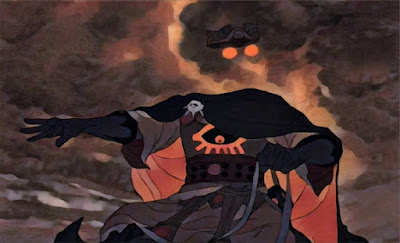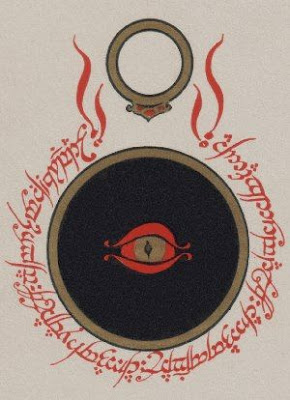The 1980 Rankin-Bass Return of the King animated film is a strange thing on many levels and is probably deserving of multiple posts dissecting its content and presentation of J.R.R. Tolkien's Middle-earth. For the moment, though, I only want to draw attention to a single, memorable image, that of the Witch-King of Angmar.
Take a look at his chest, which bears a symbol that we also see elsewhere in the film, such as on the tunic of the Mouth of Sauron.
You can also see it on the orcish helmets Frodo and Sam don while traveling in Mordor.
I think the symbol is meant to represent the Eye of Sauron, which Tolkien himself illustrated.
As you can see, there's only a very broad similarity between Tolkien's own depiction of the Eye and those used in the animated film. Tolkien's Eye does not have that bottom row of radiating lines, which might be eyelashes or might instead represent Sauron's baleful gaze. Whatever the intention, I think it's safe to say that the film version wasn't directly based on Tolkien's own illustration.
I mention all of this because, the other day, when I was compiling illustrations to include in my two posts about my favorite illustrations of Golden Age D&D, I briefly contemplated including Dave Trampier's original 1979 cover to The Village of Hommlet.
It's an absolutely phenomenal illustration. From context, I believe it is meant to depict aspects of the Ruins of the Moathouse, such as the giant crayfish and the bandits. The helmeted figure is likely "the new Master," Lareth the Beautiful, who is described as possessing a suit of magic plate mail and wielding both a mace and a staff of striking. You'll notice that both Lareth and the bandits bear a stylized eye symbol on their chests. This symbol might be associated with the cult of the Elder Elemental Eye, a mysterious being first mentioned at the end of Hall of the Fire Giant King and that may have originally had some role to play in Gary Gygax's original conception of the Temple of Elemental Evil.
Regardless, it's hard not to look on that symbol and be reminded of the Eye of Sauron. Granted, such a symbol isn't the exclusive province of Tolkien. There are plenty of examples of it in prior history, going all the way back to at least ancient Egypt, if not before. Still, it's hard even for me, a dedicated defender of the notion that Dungeons & Dragons owes very little to Tolkien, not to wonder about the ultimate inspiration for this sinister sigil.






In my early days in this hobby a search for miniature figures to represent orcs, goblins and such inevitably yielded castings with either an eye or a hand on the shield, banner, helmet, etc. Like many I repurposed the eye of Sauron to an "elemental eye" and the white hand of Saruman as a symbol of my tribe of the severed hand. It's amazing what a little paint can cover up and convert.
ReplyDeleteI've been meaning to rewatch the Rankin Bass Hobbit and ROTK. It's been a looong time.
ReplyDeleteI buy into LOTR not being the majority of influence on the game. Still, I think it's a stretch to say it didn't contribute heavily to the flavor of D&D. It's not the only time Gygax directly repurposed the Eye of Sauron motif. The orc tribes in the Monster Manual and other writings by Gygax use an eye symbol with slight variation, as detailed in this great Zenopus Archives post:
http://zenopusarchives.blogspot.com/2016/10/gygaxian-orc-tribes.html
It's just too cool of a visual and concept not to "repurpose"!
On the Agony of Tolkien Influence I'm pretty much of the opinion that Gary was being truthful in his lack of love for the work (he liked the pulps a lot more) but pretty much everyone else involved in the early days were big fans of Tolkien.
ReplyDelete"Agony of Tolkien Influence." I like that.
DeleteYes they all forced him to steal Tolkien's IP and sell it commercially, those evil players.
Delete@lore suto: Yes, among the orc tribe names in the MM are ones clearly evoking Tolkien's orc-deploying factions: Leprous Hand (Saruman's White Hand), Death Moon (Minas Morgul's skull-faced moon) and Evil Eye (of Sauron).
ReplyDeleteI always loved the witch-king's look in the Rankin Bass. I actually prefer it to the one from the Jackson movies (though both are cool). Something about the simpler crown and glowing eyes works more for me than the spiky helmet.
ReplyDeleteThe voice on the other hand, not so much. I remember loving hearing the wraith speak in the black tongue of Mordor, but the voice used in speaking human was... less than impressive.
The confrontations with the Witch King at Pelennor Fields and with the Mouth of Sauron at the Morannon are two of my favorite scenes from the books. Sadly neither has ever been done justice by any visual representations.
ReplyDelete